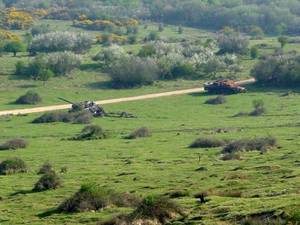Plants able to grow on toxic explosive components could clean up contaminated compounds.
Dr Liz Rylott and colleagues at the University of York have been looking at deploying Arabidopsis, a well studied weed, into military ranges. The weed has been modified to grow on toxic TNT contaminated soils and utilise the nitrogen in RDX, an explosive nitroamine more powerful than TNT.
 By using up the RDX in the soil, the plants act as decontaminators and could be used to clean up the roughly 16 million hectares of military land in the US alone that is polluted due to explosives. Despite the advantage of RDX, being almost twice as powerful as TNT, it has the disadvantage of being able to leach into the soil and potentially contaminate groundwater. Groundwater contamination is of such concern because RDX may be contributing to the 15-55% higher rate of breast cancer found in the people in the Cape Cod area. These people are supplied with water from the area containing the military range and have been compared to the USA average.
By using up the RDX in the soil, the plants act as decontaminators and could be used to clean up the roughly 16 million hectares of military land in the US alone that is polluted due to explosives. Despite the advantage of RDX, being almost twice as powerful as TNT, it has the disadvantage of being able to leach into the soil and potentially contaminate groundwater. Groundwater contamination is of such concern because RDX may be contributing to the 15-55% higher rate of breast cancer found in the people in the Cape Cod area. These people are supplied with water from the area containing the military range and have been compared to the USA average.
To develop the modified weed, the group from the Centre for Novel Agricultural Products first isolated the genes of interest from bacteria found growing on the contaminated soil. The bacteria already had developed the ability to use the explosives as a source of nitrogen, and by placing the genes into the plants they were able to transfer this ability. The plants were then able to attach a sugar molecule onto the TNT and render it non-toxic so they could grow on soils that had previously been too polluted for them to survive. These modified plants were also able to use RDX as a fertiliser and incorporate the nitrogen, a vital component of proteins and DNA, into growth.
The conversion of RDX into compounds for plant growth renders it harmless and work done in collaboration with the University of Washington has been looking at transferring the advantageous characteristic, which allowed test plants to remove the RDX from contaminated water within two to three hours, into more hardy plants such as grasses. These grasses would be able to withstand the continual bombardment and heavy trampling that is part of the daily life in a military training range. 
The fertilizing effect of RDX also means that the modified plants will actually grow faster than their competitors but only in contaminated areas. Under normal conditions the modification would confer no advantage over native species.
By showing that this technique can be used to clear up military contamination the team hope to demonstrate that a similar idea can be applied to clear up pollution on a more global scale. So perhaps in the future these "wonder weeds" will be widely wanted.
Interview with Dr Liz Rylott
- Previous Elements at Risk
- Next Using CAD to reconstruct breast tissue










Comments
Add a comment